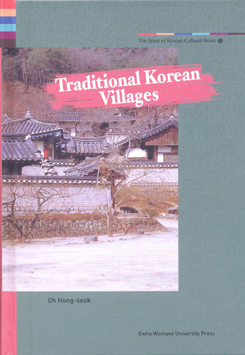
- 저자
- Oh Hong-seok 지음 | tr. by Cho Yoon-jung 옮김
- 발행일
- 2009-03-25
- 정가
- 15,000원
- 판형
- 125x180 (Hard Cover)
- 분량
- 172쪽
- 언어
- 영어
- ISBN
- 9788973007844 판매중
- 책 소 개
-
This book, the 25th in The Spirit of Korean Cultural Roots series, is an historical examination of the background to the formation of traditional Korean villages along with their functions and characteristics.
In some cases the tradition of a village is continued in harmony with historical development but in other cases it changes and sometimes disappears. Belief in the superiority of Western civilization resulting from rapid modernization has led to negative assessment of traditional elements and thus accelerated the decline of traditional villages. Under recognition of the unquestionable value of tradition, this book explores human settlements with a long history that have continued to the present time, shedding light on their nature and compositional characteristics according to their location, form, and function.
Chapter 1 examines the development and decline of the capitals of past Korean dynasties based on their ruling ideologies or belief systems. Chapter 2 describes the function and role of specialized villages such as the detached palace village near Seoul, villages round shrines, scholars' villages, and grave keepers’ villages. Chapter 3 is about regional fortress villages, which were centers of local rule, while Chapter 4 looks at villages at ports and ferry crossings with strong military or transportation functions. Chapter 5 gives an historical explanation to the formation of villages around shrines where religious rites were held, and Chapter 6 explores how the Korean ancestors adapted to the natural environment and exploited location factors to carve out their lives in farming villages, mountain villages, and fishing villages.
- 저자소개
-
지은이 : Oh Hong-seok
Ph. D. in Geography from Seoul National University
Served as professor and dean of Dongguk University,
Served as exchange professor of Utah University
Policy advisor in the fields of the environment and regional information
Editorial committee member for Seoul’s 600-Year History, History of the Hangang River, and Regional Topography of North Korea
Currently Professional Research Member of KISTI
Published Works
Study of the Settlements of Jejudo, Changamsa, 1974
Principles of Human Geography, Kyohak Publishing Co., 1982
Environmental Education, Korea National Open University Press, 1992
Korea’s Rural Villages and the Environment, Kyohakyeongusa, 1995
Looking at the Land as a Bird in the Sky, Deoksan Media, 1998
The Land Concerning Human Beings, Deoksan Media, 1999
Patterns of Spaces for Life and Death, Zoom Publishsing Co., 2003
History of Modern Korean Geography, Zoom Publishing Co., 2004
The World As I Have Experienced It, Zoom Publishing Co., 2005
The Meaning of Nature to Human Life, Zoom Publishing Co., 2006
엮음이 : tr. by Cho Yoon-jung
Cho Yoon-jung grew up in Australia and studied architecture at the University of New South Wales in sydney. She now lectures at the Graduate School of Translation and Interpretation, Ewha Womasn University
- 차 례
-
Preface
Ⅰ. Old Capitals
Gyeongju, Silla Kingdom
Capital of Baekje Kingdom
Gaeseong and Traditional Village, Goryeo Dynasty
Hanyang, Joseon DynastyII. Seoul and Neighboring Areas
Detached Palaces
Division into North and South Villages
Jongmyo Village and Sajikdan
Seonggyungwan and Scholars’ Village
Grave Keepers’ VillagesIII. Fortress Villages and Surrounds
Regional Fortress Villages
Confucian Villages
Ruling Class Villages
Middle Class and Poor VillagesIV. Transportation and Military Functions
Ferry Crossings and Port Villages
Travel Inn Villages
Mountain Fortresses and Barracks Villages
Villages around Pavilions and PlaygroundsV. Memorial Rites and Religious Functions
Shrine Villages
Villages around Shrines to Human Idols
Temple VillagesVI. Village Locations
Farming Villages on Flat Land
Mountain Villages on High Land
Fishing Villages on the Coast
Island Villages